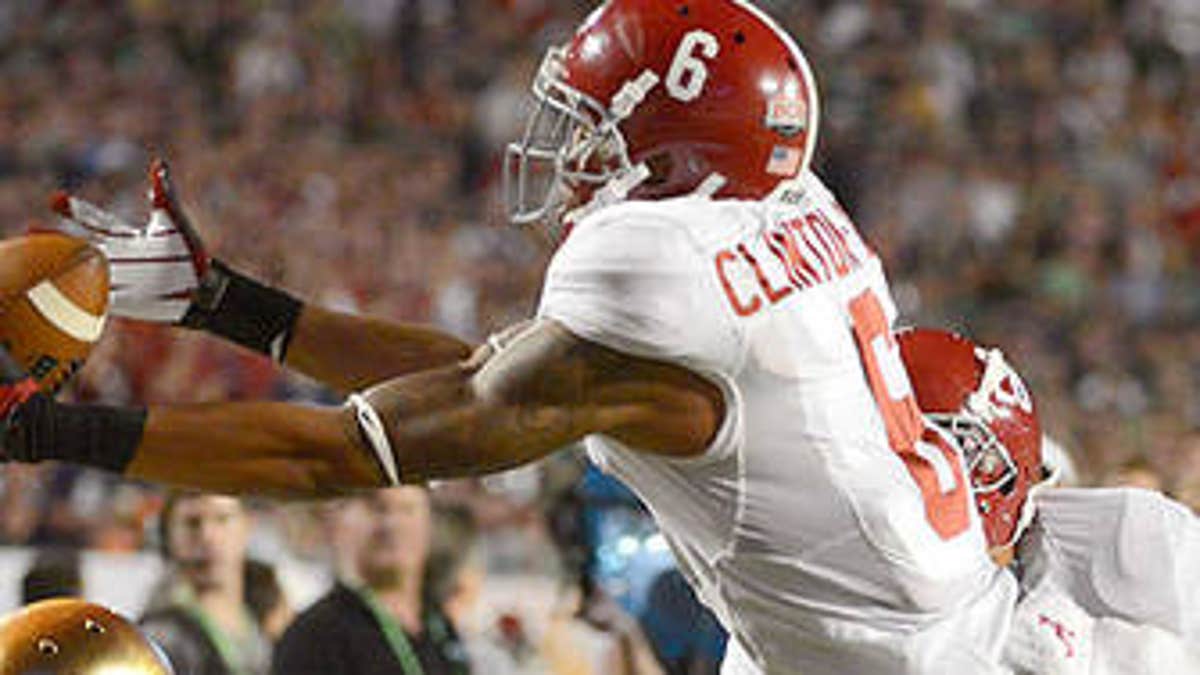
Replay it again ... please.
So targeting continues to be the talk of the early season ... and the disdain of a certain college football rules analyst.
About halfway through the second quarter, with Alabama leading Texas A&M 21-14, the Crimson Tide's Ha Ha Clinton-Dix was defending Aggies wide receiver Derel Walker on a sideline play and Clinton-Dix was called for a targeting foul and was subjected to ejection from the game.
It was deemed not targeting by the replay official and Clinton-Dix was allowed to remain.
My problem with this rule: Everybody agrees this play wasn't targeting, yet the foul stood as called because replay can't review any part of the play except the ejection.
It almost sets a double standard. Replay confirmed it wasn't targeting, and they could see clearly it was not a foul. So if the NCAA is going to go this route on the targeting foul rule and the enforcement of it, I think it should go the all the way and review the action foul as well.
Since you are already reviewing the play, in the end, why not get the whole play right?
Please.
Texas A&M was trying to make a comeback early in the 4th quarter, and it appeared they got some help.
The Aggies had the ball, first down and 10 at the Alabama 36-yard line and Quarterback Johnny Manziel completed a 24-yard pass to Derel Walker.
However, Walker went out of bounds and came back in to make the catch. A flag was thrown on Walker for illegal touching of the pass.
The officials got together to discuss the play and they ruled that Walker had been forced out of bounds by Alabama's John Fulton, thus making him eligible to come back in bounds to catch the pass. They, therefore, picked up the flag.
But it appeared that Walker's foot was on the sideline when he first touched the pass.
It's a complicated rule. The act of forcing a player out of bounds is not reviewable. Touching of the pass is, especially if the player who touches the pass has a foot out of bounds. That seemed to be the case here.
Replay should have stopped and looked at it and could have seen more replays, which may have results in the pass being incomplete.
On the very next play, A&M scored a touchdown to make it 42-28.
It's a tough job, folks.
No, I'm not talking about the coach of a top-ranked team or being the best quarterback, running back or wide receiver on a team.
I'm talking about the guys in the striped shirts -- and not those Iowa State was wearing on their game against Iowa on Fox Sports 1.
The officials.
We're quick to criticize the referees, but it's more dangerous than you might think.
Take the Vanderbilt-South Carolina game as an example.
In the second quarter, South Carolina's Connor Shaw completed a 3-yard pass to Shaq Roland who was pushed out of bounds by Darreon Herring -- right into the head linesman, Gus Morris III.
Morris was rolled upon and fell to the ground and hit his head. He eventually got up and was carted off, but you can tell he was hurting. Iknow Gus, and he's a good man. Hope he has a speedy recovery.
College players are bigger and faster than they've ever been (by the way, so are NFL players), and sometimes officials get caught in positions and can't get out of the way. The officials aren't wearing any protective padding and it can be quite dangerous if you think about it.
The interesting thing about the SEC, is that its one of the few conferences that uses alternate officials.
I know it's tough for the causal fan to show any empathy for an official, because it's easier to criticize.
But I'm telling you it's not as easy at it looks.
Tick, Tick, Tick ...
On this edition of 60 minutes -- the college football version -- I need to educate some fans ... and some coaches.
In the Central Florida-Penn State game, there was a situation that came up that I got many tweets about.
UCF was clinging to a 34-31 lead with 2:47 left in the game. Central Florida's JJ Worton caught a swing pass from quarterback Blake Bortles and ran out of bounds with 2:42 left.
The officials stopped the clock when Worton went out of bounds and once the ball was placed down at the hash marks, the officials restarted the clock.
Penn State Coach Bill O'Brien was screaming at the officials, because he thought the clock should not have started until the ball was snapped.
Wrong, coach.
That was true when you were coaching in New England. Not in State College.
The college rule is clear that when the runner goes out of bounds, the clock stops and then restarts when the ball is placed down at the hash marks. The only time the clock remains dead until the ball is snapped is if the runner goes out of bounds inside of two minutes of the second or fourth quarters.
This rule was passed in 2008 as part of the package to shorten the overall game length.
In New England (NFL), he would have been right because the clock remains stopped inside of two minutes of the second quarter and five minutes of the fourth quarter.
Keep it here throughout the day for more from Mike Pereira.
